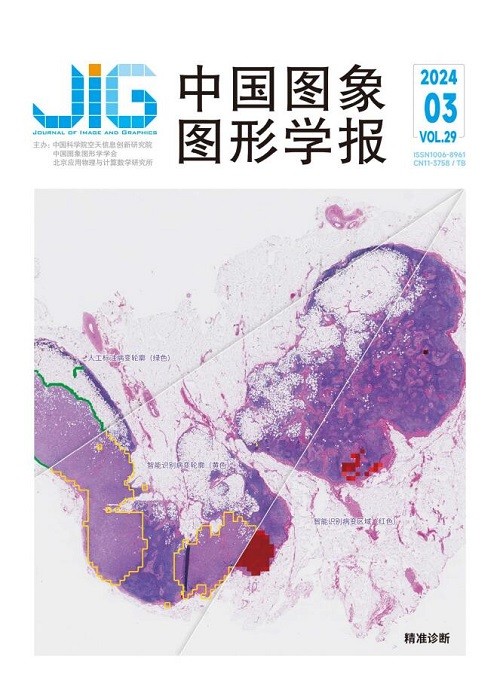
深度学习在口腔医学影像中的应用与挑战
赵阳1, 李俊诚1, 成博栋2, 牛娜君3, 王龙光4, 高广谓5, 施俊1(1.上海大学通信与信息工程学院, 上海 200444;2.西安电子科技大学计算机科学与技术学院, 西安 710000;3.南京医科大学口腔医学院, 南京 210000;4.空军航空大学电子科学学院, 吉林 130022;5.南京邮电大学先进技术研究院, 南京 210003) 摘 要
口腔医学影像是进行临床口腔疾病检测、筛查、诊断和治疗评估的重要工具,对口腔影像进行准确分析对于后续治疗计划的制定至关重要。常规的口腔医学影像分析依赖于医师的水平和经验,存在阅片效率低、可重复性低以及定量分析欠缺的问题。深度学习可以从大样本数据中自动学习并获取优良的特征表达,提升各类机器学习任务的效率和性能,目前已广泛应用于医学影像分析处理的各类任务之中。基于深度学习的口腔医学影像处理是目前的研究热点,但由于口腔医学领域内在的特殊性和复杂性,以及口腔医学影像数据样本量通常较小的问题,给深度学习方法在相关学习任务和场景的应用带来了新的挑战。本文从口腔医学影像领域常用的二维X射线影像、三维点云/网格影像和锥形束计算机断层扫描影像3种影像出发,介绍深度学习技术在口腔医学影像处理及分析领域应用的思路和现状,分析了各算法的优缺点及该领域所面临的问题和挑战,并对未来的研究方向和可能开展的临床应用进行展望,以助力智慧口腔建设。
关键词
Applications and challenges of deep learning in dental imaging
Zhao Yang1, Li Juncheng1, Cheng Bodong2, Niu Najun3, Wang Longguang4, Gao Guangwei5, Shi Jun1(1.School of Communication and Information Engineering, Shanghai University, Shanghai 200444, China;2.School of Computer Science and Technology, Xidian University, Xi'an 710000, China;3.School of Stomatology, Nanjing Medical University, Nanjing 210000, China;4.College of Electronic Science, Air Force Aviation University, Jilin 130022, China;5.Institute of Advanced Technology, Nanjing University of Posts and Telecommunications, Nanjing 210003, China) Abstract
Dental imaging is an essential tool for the detection, screening, diagnosis, and therapeutic evaluation of clinical oral diseases, and the accurate analysis of the images is vital to the development of subsequent treatment plans. Deep learning, which is widely used in many fields, such as machine translation, speech recognition, and computer vision, can automatically learn and obtain superior feature expressions from large sample data, thereby improving the efficiency and performance of various machine learning tasks. With the integration of artificial intelligence and various fields, smart healthcare has become an important application area of deep learning, providing an effective way of solving the following clinical problems:1) the shortage of experienced radiologists in the field of dentistry cannot meet the rapidly growing medical demand. 2) Despite sufficient medical resources, the number of experienced physicians cannot meet the rapidly growing medical demand. 3) Different physicians have different interpretations of the same oral image, which are influenced by subjectivity. Deep learning-based dental image processing is currently a popular research topic. The inherent specificity and complexity of the medical field and the problem of insufficient dental image data samples bring new challenges to the application of deep learning methods in relevant learning tasks and scenarios. This work mainly reviews the various applications of deep learning methods using three major dental imaging methods (i. e., two-dimensional oral X-ray images, threedimensional tooth point cloud/mesh images, cone beam computed tomography(CBCT)). These applications include tooth segmentation, caries detection, and tumor detection. The reviews on two-dimensional oral X-ray images focus on bitewing, periapical, and panoramic X-rays based on deep learning methods. Bitewing X-rays usually show the contact surface from the distal end of the canine to the most distal molar and are mainly used to diagnose proximal caries, assess the extent of caries, and identify secondary caries under existing restorations. For caries detection using bitewing X-rays, we mainly review deep learning methods using convolutional neural network architectures, such as full convolutional neural networks and U-Net architectures. Periodontitis and caries detection using periapical X-rays primarily introduces methods based on convolutional neural networks and backward propagation neural network. In contrast to bitewing and periapical X-rays, panoramic X-rays show not only teeth and gums but also the jaw, the skull, the spine, and other bones. We provide a focused review of the application of deep learning methods in panoramic radiographic images from three detection categories of directions:tooth detection and numbering, tooth segmentation, and non-dental disease detection. The threedimensional tooth point cloud/mesh image is a digital 3D oral model obtained by scanning and reconstructing the patient's mouth in real time using an intraoral scanner. The reviews on the three-dimensional tooth point cloud/mesh image focus on tooth segmentation based on deep learning. The deep learning methods for tooth segmentation can be divided into two categories:fully supervised and non-full supervision methods. For fully supervised methods, we mainly introduce the hierarchical and end-to-end network architecture models with a large amount of labeled data and annotation. For non-full supervision methods, we primarily review self- and semi-supervised learning methods that only require partially annotated data and methods that utilize weakly annotated ideas. Currently, CBCT imaging, which is a non-invasive, low-radiation technique, is widely used in dental diagnosis and treatment. This paper summarizes the deep learning methods for CBCT images, focusing on three major areas:tooth segmentation, dental implants, and oral and maxillofacial surgery. Nevertheless, analyzing all aspects of the patient's oral and systemic health status to develop a personalized and high-level treatment plan for oral diseases using the deep learning methods that have been proposed is still difficult. Deep learning has made some progress in the field of dental image processing but still faces some serious challenges. The small sample size has been a serious problem in the field of medical image analysis but can be effectively addressed using non-fully supervised deep learning methods, such as weakly supervised learning and self-supervised learning, with machine learning methods, including migration learning, sample less learning, and incremental learning. In addition, the annotation of dental medical images is a timeconsuming and laborious task that relies heavily on the experience of the practitioner, which is one of the barriers limiting the extensive and intensive application of deep learning. Therefore, automatic data annotation must be extensively studied. The development of deep learning applications in dental imaging is still in a relatively early stage. The development of this field cannot be achieved without the cooperation of computer scientists, clinicians, and experts in imaging equipment and software development in solve the problem of deploying lightweight deep learning networks in convenient medical devices. Therefore, the combination of deep learning and dental image analysis has been a major trend, with significant results in various analysis tasks, but require further research to lead the development of dental image analysis to a new phase.
Keywords
deep learning dental imaging tooth detection and segmentation caries detection computer-aided diagnosis (CAD)
|



 中国图象图形学报 │ 京ICP备05080539号-4 │ 本系统由
中国图象图形学报 │ 京ICP备05080539号-4 │ 本系统由